Roomba: Difference between revisions
→In popular culture: Copyedit (major) |
Wolfgang42 (talk | contribs) m →See also: Disambiguate Scooba -> Scooba (brand) |
||
| Line 178: | Line 178: | ||
* [[Robotic mapping]] |
* [[Robotic mapping]] |
||
* [[Robotics suite]] |
* [[Robotics suite]] |
||
* [[Scooba]] floor washer, iRobot's second home robot |
* [[Scooba (brand)|Scooba]] floor washer, iRobot's second home robot |
||
==References== |
==References== |
||
Revision as of 17:55, 2 March 2014
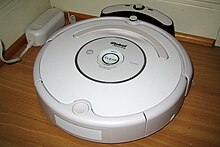
Roomba is a series of autonomous robotic vacuum cleaners sold by iRobot.
Roomba was introduced in 2002.[1] As of Feb 2014[update], over 10 million units have been sold worldwide.[2] Roomba features a set of basic sensors that help it perform tasks. For instance, the Roomba is able to change direction on encountering obstacles, detect dirty spots on the floor, and detect steep drops to keep it from falling down stairs. It uses two independently operating wheels that allow 360 degree turns. Additionally, it can adapt to perform other more "creative" tasks using an embedded computer in conjunction with the Roomba Open Interface.
Description
This section needs additional citations for verification. (May 2013) |
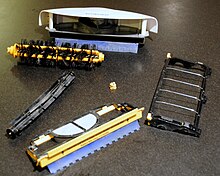
All Roomba models are disc-shaped, 34 cm (13") in diameter and less than 9 cm (3.5") high. A large contact-sensing mechanical bumper is mounted on the front half of the unit, with an omnidirectional infrared sensor at its top front center. A recessed carrying handle is fitted on the top of most units.[3]
As of 2012, there have been four generations of Roomba units: the first-generation original models, the second-generation "Discovery" series, the third-generation 500 series and the fourth-generation 600/700 series.[4] All utilize a pair of brushes, rotating in opposite directions, to pick up debris from the floor. In most models, the brushes are then followed by a squeegee vacuum, which directs the airflow through a narrow slit to increase its velocity in order to collect fine dust. A horizontally mounted "side spinner" brush on the right side of the unit sweeps against walls to reach debris not accessible by the main brushes and vacuum. In the first generation of robots, the dirty air passes through the fan before reaching the filter, while later models use a fan-bypass vacuum.
The Roomba is powered by removable nickel-metal hydride batteries (NiMH), which must be recharged regularly from a wall power adapter. Newer second and third generation models have a self-charging homebase which they automatically try to find at the end of cleaning session via infrared beacons. Charging on the homebase takes about three hours. Four infrared "cliff sensors" on the bottom of the Roomba prevent it from falling off ledges such as the top steps of stairways. Most second- and third-generation models have internal acoustic-based dirt sensors (The Dirt Detect Series 1 Technology) that allow them to detect particularly dirty spots (zones having excess particulates) and focus on those areas accordingly. Fourth generation models have an optical sensor located in front of the vacuum bin (The Dirt Detect Series 2 Technology) allowing Roomba to detect wider and smaller messes.[5] Many second and third generation Roombas come packaged with IR (infrared) remote controls, allowing a human operator to "drive" the robot to areas to be specially cleaned.
Some higher-end 500 and 700 series robots are compatible with "Virtual Wall Lighthouses",[6] which use RF to communicate. These more-advanced Virtual Wall accessories confine a Roomba to a fixed area to be cleaned, yet allow the cleaner to later proceed to the next space to be cleaned.[7]
iRobot has released several types of dust and debris collection bins for the 500 Series robots. The standard "Vacuum Bin" incorporates the separate squeegee vacuum, as with all prior models. The "High Capacity Sweeper Bin" does not include a vacuum, but has greater capacity for debris collected by the brushes. The "Aerovac Bin" directs suction airflow through the main brushes instead of using a squeegee, which is thought to keep the brushes cleaner.
Operation

All Roomba models can be operated by manually carrying them to the room to be cleaned and pressing the appropriate button. Later models introduced several new operating modes. "Clean" mode is the normal cleaning program, starting in a spiral and then following a wall, until the room is determined to be clean. "Spot" mode cleans a small area, using an outward-then-inward spiral. "Max" runs the standard cleaning algorithm until the battery is depleted. "Dock" mode, introduced with the third generation, instructs the robot to seek a self-charging homebase for recharging. The availability of the modes varies depending on model, generally with higher-end units having more features.
The robot's bumper prevents them from bumping into walls and furniture by reversing or changing path accordingly. The third- and fourth-generations, which move faster than previous models, have additional forward-looking infrared sensors in its bumper to detect obstacles. These slow down when nearing obstacles to reduce its force of impact (Light Touch Technology).[8] Additionally, this technology is able to distinguish between soft and solid barriers. After a sufficient period of time cleaning, the Roomba will either search for and dock with the homebase, or stop where it is.
The cleaning time depends on room size and, for newer models equipped with acoustic dirt sensors, volume of dirt. First-generation models must be told the room size, while second- and third-generation models estimate room size by measuring the longest straight-line run they can perform without bumping into an object. When finished cleaning, or when the battery is nearly depleted, a second- or third-generation Roomba will try to return to a homebase if one is detected. A second-generation Roomba may also be used with the external Scheduler accessory, allowing cleaning to start automatically at the time of day and on days of the week that the owner desires. Most 500 Series robots support scheduling through buttons on the unit itself, and higher-end models allow the use of a RF remote to program schedules.
Unlike the Electrolux Trilobite vacuuming robots, Roombas do not map out the rooms they are cleaning. Instead, iRobot developed a technology called iAdapt Responsive Cleaning Technology.,[9] Roombas rely on a few simple algorithms such as spiral cleaning (spiraling), room crossing, wall-following and random walk angle-changing after bumping into an object or wall. This design is based on MIT researcher and iRobot CTO Rodney Brooks' philosophy that robots should be like insects, equipped with simple control mechanisms tuned to their environments. The result is that although Roombas are effective at cleaning rooms, they take several times as long to do the job as a person would. The Roomba may cover some areas many times, and other areas only once or twice. The Virtual Wall accessories project infrared light beams which the Roomba will not cross. Newer model Scheduler Virtual Walls can be set up to turn on via IR at the same time a Roomba is activated. As Virtual Walls are battery-powered, this is desirable to avoid wasting power projecting IR beams when not needed.
The Roomba is not designed for deep-pile carpet. Also, the first- and second-generation Roombas can get stuck on rug tassels and electrical cords. The third-generation is able to reverse its brushes to escape entangled cords and tassels. Additionally, all models are designed to be low enough to go under a bed or most other items of furniture. If at any time the unit senses that it has become stuck, no longer senses the floor beneath it, or it decides that it has worked its way into a narrow area from which it is unable to escape, it stops and sounds an error to help its owner find it. Early models use only flashing lights to indicate specific problems, while later models use voice synthesis to announce a problem and a suggested solution.[10]
General maintenance of the Roomba consists of emptying the debris bin and cleaning the dust filter, as well as removing and cleaning the brushes. Excessive hair accumulation in the brush system can cause the brushes to stall, or overload the brush motor, damaging the unit. Lesser amounts of hair build-up will merely slow down the brushes, reducing cleaning effectiveness and battery life. Special "pet-friendly" options and models are available, which are supposed to be more resistant to hair build-up, and easier to clean.
Battery life and reliability
Battery reliability is a frequently-mentioned complaint on the iRobot, Amazon, and other third-party customer review websites. Battery replacements from iRobot cost a significant fraction of the purchase price of a new Roomba, though compatible third-party batteries are available at a lower price. The iRobot customer support website offers advice on maximizing battery performance and longevity.[11] All batteries will gradually lose energy capacity, resulting in shorter cleaning runs, eventually necessitating replacement. Roomba batteries are end user replaceable within minutes.
When a Roomba owner is absent for an extended period (such as a vacation or due to illness), automatically scheduled cleaning runs should be canceled.[12] For example, if it becomes entangled and stops with an error sound on an unattended session, the battery will remain deeply discharged for an extended period, often resulting in permanent damage to the battery.
Accessories
- Easy Clean Brush — A brush that is designed specifically for cleaning pet hair, being easier to clean off (standard on models designated "for pets").
- Remote Control — Allows the owner to remotely operate basic Roomba functions (works with all second- and third-generation Roombas).[13]
- Wireless Command Center — Allows the owner to remotely operate most Roomba functions, including scheduling (works only with certain third-generation Roombas).[14]
- iRobot Scheduler — Allows the owner to program the Roomba to clean at certain times automatically. The "Schedule Upgrade" accessory will also update a pre-2.1 Roomba to the 2.1 software (for second-generation Roombas).
- Homebase — The Roomba automatically returns to and docks here for recharging (for second- and third-generation Roombas).
- Virtual Wall — Used for keeping the Roomba out of designated areas.[6][7]
- Virtual Wall Lighthouse — Functionality of Virtual Wall with an additional "Lighthouse" mode, which will contain Roomba in one room until the room is completely vacuumed before moving on to the next.[6] As of 2012, iRobot has sold at least 5 different Virtual Wall designs, with different cases and capabilities.[7]
- Virtual Wall Halo — Designates a circular zone 20" (50 cm) in diameter to protect small items, like pet water and feeding bowls, from being disturbed by a Roomba[15]
- OSMO — A temporary dongle that attaches to the serial port on the Roomba to update a pre-2.1 Roomba's firmware to version 2.1; this also can correct the "circle dance" problem (for all second-generation Roombas).
- Advanced Power System (APS) Battery — Higher-performance rechargeable battery for all models that holds enough power to clean for 200 minutes.
- Roomba Serial Control Interface (Roomba SCI) — Exposes all the functionalities and sensor information from the iRobot Roomba vacuum cleaner for external interfacing. Using the SCI, a roboticist can command and control the Roomba by connecting to the 7-pin Mini-Din UART port.
- Roo series of accessories, by RoboDynamics
- RooTooth — A Bluetooth module that converts the Roomba to Bluetooth control from any bluetooth device.
- RooStick — Allows programming input through a USB interface.
- Roo232 — Allows programming input through a serial port connector.
- RoombaFX — A C# class by RoboDynamics that implements the entire Roomba SCI command set. Available on Source Forge for download and user contributions.[16]
Models
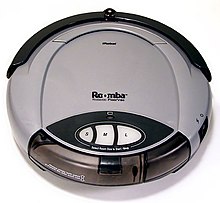
First generation
Introduced in 2002, the first-generation Roomba had three buttons for room size. The first-generation units comprise the original, silver-colored Roomba, the blue Roomba Pro, and the maroon Roomba Pro Elite. The latter two models included additional accessories, but all three use the same overall core robot and cleaning system.
400 series
The second-generation Roombas (dubbed "Discovery", later called "400 series") replaced their predecessors in July 2004, adding a larger dust bin, better software that calculates room sizes, dirt detection and fast charging in the home base (or wall hanger in the case of the Discovery SE). All second-generation Roombas are functionally identical, though some have more or fewer buttons, accessories, or different external designs. Version "2.1" contained updated software and a new front wheel. Version "2.1" was issued in 2005, and the update was made available to existing units as well. The low-end models continued to be available after the introduction of the 500-series with new, three-digit model names.
Roomba budget models (Dirt Dog and Model 401) have a simplified interface (a single "Clean" button) and lack some of the software-controlled flexibility of other versions. They are positioned to be less-expensive versions of the Roomba for first-time purchasers. The Roomba Dirt Dog contains sweeping brushes and a larger dust bin, but lacks the vacuum motor. It uses the space that would be required for the vacuum for additional dust bin volume. It was designed for home shop or home garage environments.[6] The Dirt Dog was discontinued in 2010. The Roomba Model 401 is similar but has a "standard" size dust bin and vacuum system. Budget models are upwards-compatible with the extended-life batteries, fast charger and schedulers of the 400 series.
500 series
The third-generation 500 series Roomba was first introduced in August 2007,[6] and features a forward-looking infrared sensor to detect obstacles and reduce speed, a "Dock" button and improved mechanical components & smoothness of operation.[6][17] It also introduced customizable decorative face plates.[6] The Roomba 530 came with two Virtual Walls and a recharging dock.[6]
600 series
The 500 series have been superseded by the 600 series in August 2012. All models come with the AeroVac bin and the Advanced Cleaning Head:[32]. (Also see the "List of Models 2012+" below)
700 series
In January 2011, iRobot announced the Roomba 700 Series robots.[18] Although largely similar to the 500 series, the 700 series features a number of improvements. Among these are a more robust cleaning system, improved AeroVac bin with HEPA filter and improved battery life.
Like the 500 series, the 700 series includes robots with different technologies and accessories. The Roomba 760 is the simplest of the robots, and Roomba 790[19] is the newest and most advanced with both scheduling and a large range of accessories including Lighthouses, Wireless Command Center and extra brushes and filters. Besides these two models, also Roomba 770[20] and 780 are available[21] – both with scheduling, DirtDetect 2 and full bin indicator.
The updated models started shipping in May 2011.
List of models
2002+
The first generation:
- Roomba (2002, improved in 2003, discontinued)
- Roomba Pro (2003, discontinued)
- Roomba Pro Elite, model # 3100, (2003, discontinued)
The first-generation Roombas have three buttons for room size
2004+
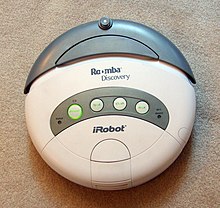

The second-generation Roombas (dubbed "Discovery", later called 400 series) replaced their predecessors in July 2004, adding a larger dust bin, better software that calculates room sizes, fast charging in the home base (or wall hanger in the Discovery SE), and dirt detection. All second-generation Roombas are functionally identical, though some have more or fewer buttons, accessories, or casings, and all featured updated programming after mid-2005. The low-end models continued to be available into 2007 with new model names. In the UK, different model numbers were used (confusingly, many starting with 5 despite still being '400 series' models e.g. 5545, 5247, 5107, 5105)
- Second Generation (2G) (All 2G Roombas can be updated to 2.1G Roombas)
- Dirt Dog, model # 1100 (sweeper only, no vacuum) [6]
- Roomba, model # 4000, now model # 400 (2006)[22] (September 2006)
- Roomba Red, model # 4100, now model # 410 (2004, improved to 2.1G in 2005)[23]
- Roomba Sage, model # 4105, now model # 416 (2004, improved to 2.1G in 2005)[24]
- Roomba Sage, model # 4110, now model # 416 (identical to # 4105, but includes charging base)
- Roomba Clean Blue, model # 4130, (HSN exclusive model, earliest release of 2.1G Roomba at a special preview price, identical to the 2.1G Sage except for color.(2004, discontinued)
- Roomba Clean Blue, model # 4130, (HSN exclusive model, earliest release of 2.1G Roomba at a special preview price, identical to the 2.1G Discovery except for color) (2004, discontinued)(Although confusing it should be noted both HSN models share the same model number (4130) despite being two very different models.)[25]
- Roomba Silver, model # 4150, (Amazon.com & Target exclusive model, identical to # 4105, except for a special silver finish)
- Roomba Sage for Pets, model # 4170 (2006)[26]
- Roomba Pink Ribbon Edition, model # 4188, (Identical to # 4105 except for color with 20% of the sale price was donated to the Susan G. Komen Breast Cancer Foundation) (2005, discontinued)
- Roomba Discovery, model # 4210, (2004, improved to 2.1G in 2005)[27]
- Roomba Discovery SE, model # 4220, (2004, identical to Discovery 4210 but with different paint and self-charging wall mount; improved to 2.1G in 2005, discontinued)
- Roomba Scheduler, model # 4225, (same as 4230, but sold at Costco)
- Roomba Scheduler, model # 4230, (2005)[28]
- Roomba Scheduler, model # 4260, with Intelli-Bin (auto detection of a full refuse bin) (Sold at Hammacher-Schlemmer)
- Roomba Discovery for Pets (2006)[29]
- Roomba Scheduler with Intelli-Bin (July 2006)[30]
2007+

iRobot 500 series or third Generation (according to the official iRobot website).[31] The third-generation 5xx Roomba was introduced in 2007 and features an infrared sensor to detect obstacles, a dock button and improved mechanical components. Some second-generation models remained on sale as the 4xx series. The 500 had double the cleaning capacity of the last generation.[6] The base of all Roomba 500 series models are the same, they only differ in some features (handle, scheduling, bin type) and included accessories. iRobot has sold the same robots with different model numbers in each regions, and created some unique bundles for some regions. The Roomba 535 and up are compatible with scheduling and with the wireless command centre, whereas Roomba models 550 and up include on-board scheduling.[32]
- Roomba 510
- Roomba 530[6]
- Roomba 532 (similar to a 530, with enhanced components for pets)
- Roomba 535 (HSN Version)
- Roomba 550 (Costco Version, 540 Costco Canada Version)[33]
- Roomba 560[6]
- Roomba 562/564 (like a 560, with enhanced components for pets)
- Roomba 570/571
- Roomba 572 (like a 570, with enhanced components for pets, 572 Costco Canada Version)
- Roomba 580/581 (580 released in August 2007)
- Roomba 610 (Roomba PRO)
2011+

In 2011, three new improved models (all come with the new AeroVac series 2 bin):[34]
- Roomba 760 - no full bin indicator, original Dirt Detect sensor, button interface, one virtual wall, no lighthouse feature
- Roomba 770 - full bin indicator, Dirt Detect 2 sensors, button interface, two virtual walls, no lighthouse feature
- Roomba 780 - full bin indicator, Dirt Detect 2 sensors, touch sensitive interface, two virtual walls / lighthouses, set of spare filters and brushes
- Roomba 790 - full bin indicator, Dirt Detect 2 sensors, touch sensitive interface, two virtual walls / lighthouses, set of spare filters and brushes, wireless command centre.
iRobot sells the 700 series models with the same model numbers in all regions.
2012+
The 500 series have been superseded by the 600 series in August 2012. All models come with the AeroVac bin and the Advanced Cleaning Head:[34]
- Roomba 620 - Basic model
- Roomba 630 - Includes an Auto On virtual wall
- Roomba 650 - Auto On virtual wall, scheduler.
- Roomba 660 - Auto On virtual wall, scheduler, iAdapt.
2013+
The 600 series now superseded by the 700 series which ran alongside the 600 series for a period of time in 2012. There are several models in the 700 series:[35]
- Roomba 760 - Base model
- Roomba 770 - As 760 but includes - Dirt Detect Series 2 Technology and Full Bin Detection
- Roomba 780 - As 770 but includes - Room-to-room navigation, Capacitive Touch Control panel and Virtual Wall Lighthouses (which replace Auto Virtual Walls)
- Roomba 790 - As 780 but includes - Wireless Command Center, 3 Virtual Wall Lighthouses and Storage Case
- Roomba 880 - As 790 but includes - Batteries all included, 1 Xlife battery, 1 Extra HEPA filter, aerovac tube bin (which adds more into Roomba)
Hacking and extending Roomba
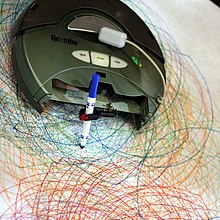
From the earliest models on, Roomba vacuum cleaning robots have been hacked to extend their functionality. The first adaptations were based on a micro controller that was directly connected to the motor drivers and sensors.[36] Versions manufactured after October 2005 contain an electronic and software interface that allows hackers to more easily control or modify behavior and remotely monitor its sensors.[37] One early application was using the device to map a room.[38]
Models with an interface (400 series from October 2007 and the newer 500 and 700) come with a Mini-DIN connector supporting a TTL serial interface, which is electrically and physically incompatible with standard PC/Mac serial ports and cables. However, third-party adapters are available to access the Roomba's computer via Bluetooth, USB, or RS-232 (PC/Mac serial).[39] Roombas pre-October 2005 upgraded with the OSMO Hacker[40] device allow the user to monitor the many sensors and modify its behavior. The Roomba Open Interface (formerly "Roomba Serial Command Interface") API allows programmers and roboticists to create their own enhancements.[41][42] Several projects are described on Roomba hacking sites.[43]
In response to the growing interest of hackers in their product, the company developed the iRobot Create. In this model the vacuum cleaner motor is replaced by a "cargo bay" for mounting devices like TV cameras, lasers and other robotic parts. Create provides a greatly enhanced 25-pin interface providing both analog and digital bidirectional communication with the hosted device, allowing use as the mobile base for completely new robots. Together with a computing platform like a netbook or handheld device with wireless networking, it can be remotely controlled through a network.[44]
In popular culture
Jesse Pinkman, of AMC's series Breaking Bad, owns a Roomba, which startles his friends [in "Thirty-Eight Snub" (S4/E2)] and later plays a role in his and Walter White's search for the "ricin cigarette" that may have poisoned Brock Cantillo.[45][46]
See also
- Comparison of domestic robots
- Domestic robot
- RoboMower lawn mower home robot, manufactured by Friendly Robotics
- Robotic mapping
- Robotics suite
- Scooba floor washer, iRobot's second home robot
References
- ^ "iRobot Corporation: Our History". Irobot.com. Retrieved 2013-11-24.
- ^ "About iRobot". Irobot.com. Retrieved 2014-02-11.
- ^ "iRobot Roomba 560 Video Review". Robot Reviews. Retrieved 18 September 2013.
- ^ "iRobot Roomba 560 - Compared with Roomba 700 series at Roomba Robot Reviews". PRLog. Retrieved 18 September 2013.
- ^ "What is Roomba's Dirt Detect technology?". Uksupport.irobot.com. Retrieved 2013-01-29.
- ^ a b c d e f g h i j k l [1] [dead link]
- ^ a b c "What are Roomba® Virtual Walls®?". iRobot Customer Care. iRobot. Retrieved 2012-03-04.
- ^ "iRobot: Customer Care - Roomba® 500/600/700 Series Light Touch Technology". Homesupport.irobot.com. Retrieved 2013-01-29.
- ^ [2] [dead link]
- ^ "How can I prevent Roomba® from getting stuck?". iRobot Customer Care. iRobot. Retrieved 2012-03-04.
- ^ "Roomba® 500/600/700 Series Battery Maintenance Tips". iRobot Customer Care. iRobot. Retrieved 2012-03-04.
- ^ iRobot owner's manual or online help website
- ^ "What is the Roomba® 500/600/700 Series Remote Control?". iRobot Customer Care. iRobot. Retrieved 2012-03-04.
- ^ "What is the Roomba® 500/600 Series Wireless Command Center?". iRobot Customer Care. iRobot. Retrieved 2012-03-04.
- ^ "What is the Virtual Wall® Halo?". iRobot Customer Care. iRobot. Retrieved 2012-03-04.
- ^ "RoombaFX beta by bluewhackadoo". Anonymous. Retrieved 13 July 2010.
- ^ "Official iRobot Website". Homesupport.irobot.com. Retrieved 2009-06-09.
- ^ "iRobot Corporation: Press Release". Irobot.com. 2011-01-03. Retrieved 2012-03-04.
- ^ "iRobot Corporation: Roomba 790". Irobot.com. Retrieved 1 July 2012.
- ^ "iRobot Roomba 770". Robotexpert.co.uk. Retrieved 5 September 2012.
- ^ "robotstofzuigerexperts Corporation: Press Release". 2013-12-13.
- ^ "iRobot - iRobot Roomba® 400 Vacuum Cleaning Robot". Store.irobot.com. Retrieved 2012-03-04.
- ^ "iRobot - iRobot Roomba® 410 Vacuum Cleaning Robot". Store.irobot.com. Retrieved 2012-03-04.
- ^ "iRobot - iRobot Roomba® 416 Vacuum Cleaning Robot". Store.irobot.com. Retrieved 2012-03-04.
- ^ "Home Solutions: Home Cleaning, Improvement & Organization Products at". Hsn.com. Retrieved 2012-03-04.
- ^ "iRobot: Search for". Store.irobot.com. Retrieved 2012-03-04.
- ^ "iRobot: Search for". Store.irobot.com. Retrieved 2012-03-04.
- ^ "iRobot: Search for". Store.irobot.com. Retrieved 2012-03-04.
- ^ "iRobot: Search for". Store.irobot.com. Retrieved 2012-03-04.
- ^ "iRobot: Search for". Store.irobot.com. Retrieved 2012-03-04.
- ^ "iRobot: Customer Care - What robots are included in the Roomba® Discovery/400 Series?". Homesupport.irobot.com. Retrieved 2013-11-25.
- ^ "iRobot Roomba 500 Series compatibility". Retrieved 2012-03-04.
- ^ "No results were found for "roomba"". Costco. Retrieved 2012-03-04.
- ^ a b "Comparison Chart Image". Robot Reviews. Retrieved 18 September 2013.
- ^ "Roomba 700 Series Product Comparison". iRobot.com. Retrieved 18 September 2013.
- ^ "Discussing and Dissecting the Roomba 780 ad Scooba 230". Roomba Community. Retrieved 2012-03-04.
- ^ "iRobot Roomba Serial Command Interface (SCI) Specification" (PDF). Irobot.com. Retrieved 2013-11-24.
- ^ Gerkey, Brian (2006-03-31). "Robotic mapping for Roomba". Artificial Intelligence Center. SRI International. Retrieved 2013-06-13.
- ^ "Roomba Development Tools". Archived from the original on 2006-07-11. Retrieved February 1, 2007.
- ^ "OSMO - RoombaDevTools.com". Web.archive.org. 2007-01-15. Retrieved 2013-11-25.
- ^ "iRobot Roomba Serial Command Interface (SCI) Specification" (PDF). iRobot Corporation. October 2005. Retrieved February 1, 2012.
- ^ "iRobot Corporation: Roomba Open Interface". Kibertron.org. 2005-10-24. Retrieved 2009-06-09.
- ^ "Roomba hacking projects". Hackingroomba.com. Retrieved February 6, 2013.
- ^ "Roomba Robot project". Irobot.com. Retrieved 2012-03-04.
- ^ "The 25 Best Moments In Breaking Bad: (9) The Roomba Vacuum Cam". Empire Online. p. 9.
- ^ Margaret Lyons (August 26, 2013). "What Jesse Knows — and What We Still Don't Know — About the Ricin on Breaking Bad". Vulture.
External links
- iRobot, manufacturer and US retailer of Roombas
- RobotReviews.com, The largest and most active discussion site for Roomba users
- C# RoombaSCI, Open Source C# Programming Framework for Roomba
- Roboticall.com, Most detailed robotic vacuum cleaner reviews
- Roomba Tear Down Guide, Step-By-Step Roomba Tear Down and Repair
- Comprehensive guide to programming Roomba, Comprehensive guide to programming Roomba (with code examples)
- Roomote iOS app for controlling Roomba via serial or Bluetooth connection
- Roomba Repair Guide, Information About Common Bump Sensor Error[9-Beep Error]
